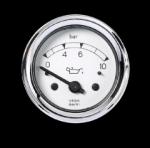-
Posts
1,561 -
Joined
-
Last visited
-
Days Won
2
Everything posted by raz
-
Most of us never ride in sub freezing-point temperatures. Anyway I don't expect pressure to go much higher. The acceptable OPRV range according to the WHB is 55-60 psi or you should otherwise fix it. But I'm guessing the initial higher value is not caused by a bad OPRV, but the OPRV like everything else will not do exactly what you might expect with cold and thick oil. Hopefully we can now analyze this issue in 12 pages without really having a clue FWIW, as a comparison the oil lamp should go away somewhere between 2 and 5 psi! Just so you get the picture. Me thinks that is very low... Pound is a currency. Inch is an ancient unit based on the width of a carpenter's thumb. Wake up
-
Those 80 psi John and Polebridge witnesses would be 5.5 bar, but that is just for a short time when stone cold. I was thinking of buying a Vega kit from Stein-Dinse, ranging 10 bar but I think I would rather have one ranging 5 bar as the OPRV is 4.2 bar and a 52 mm unit is pretty low resolution. On the other hand, a 10 bar gauge would show needle almost in the middle for normal operation, which is pretty sane.
-
Did you read John's report earlier in this thread? I think he had 60 psi at idle. I'm not qualified to answer if 40 psi is OK, but my guess is it is, as long as you've got the 60 on higher rpm.
-
The OPRV is rated 55-60 psi. John mentioned 80 psi but I think that was for a much shorter time. What weight oil are you using?
-
Thanks Ernst! Great post, backed up with interesting graph.
-
It was recently discussed here: http://www.v11lemans.com/forums/index.php?...st&p=135971 I don't know of anyone with a V11 that has it connected. I intend to experiment with it later.
-
For what it's worth; when I mounted my guards I changed the M6x25 mm screws involved, to M6x30 mm, in order to still use the available threads in the head. It may seem insignificant but I suspect it just might be what eventually saves the day.
-
I was not thinking quicker, but better. Like the rings are not 100 % symmetrical nor is the cylinder so a keyed ring could break in to an exact match giving a better seal than a floating ring could ever reach. But I guess there are more things consider. Not to mention I may be completely wrong here
-
But of course, all oil will enter the sump via the spine frame . This renders the oil cooler redundant too! Hostile Forum Disclaimer: I'm not attacking Ratchethack or anyone else, it was just a joke. Disclaimer disclaimer: The last was also a joke
-
Man, that was really obvious. Note to self: use brain.
-
OK, then one thing I have had in mind is the piston rings not being keyed into position. Are they rotating slightly all the time? If so I guess there is reason to have them do that. The 50cc two-strokes I've seen has had a key so the rings were fixed. I would have thought they could brake in to better seal if they were not rotating. So, is this a 2-stroke vs 4-stroke thing or are there keys in some big 4-strokes too? Maybe this should go to a fresh thread so people can find it. Thanks!
-
Pete, what makes you think we're not interested? Are you waiting for us to take a shot on that question? If I got it right, the bearing is very soft compared to the journal and that means hostile particles can (to an extent) embed in the cheap bearing instead of ruining the crank. One particular thing I don't get is how the little end bearing gets its oil. Please continue!
-
I'm sure Ryland understands that, he just made an exact measurement once and for all and documented the conditions very well (ok it was anal but that is much better than establishing an incorrect figure). I appreciate it because this means I can use a 4 liter bottle without worrying about it.
-
It is possible. Before any tuning one should check TPS, valves, replace/clean air filter, perhaps new plugs and so on in order to have the standard baseline one can go back to. But you are right, someone could have made a tune with a wrong TPS base setting. If this is the case (and is undocumented) you now learn the hard way why this is so bad - you won't know what to set it to I agree with docc, if only to convince us, and yourself, you really didn't miss something in the process.
-
Any dynoing/tuning should start with fresh TPS adjustment, so if anything this should make it more close to what was once tuned. The 150 mV is important for that. The higher setting you can fiddle about with (eg. to lower idle), not the base 150 mV.
-
Thanks Pete. This reminds me of something I came across recently. This guy Motoman (an old wierd Internet site with some arguable but interesting views on tuning) claims that the assembled rod shells are (can be?) very sligthly elliptic, to account for big end inner diameter stretching on high RPM. Is that true at all? You wrote the opposite but that could be a simplification I guess. Or maybe his statement is for high RPM japs, not ditch pumps like ours. http://mototuneusa.com/circular_logic.htm (half-way down and then some)
-
For what it's worth, some synch gauges I looked at ranged to 0.6 bar (9 psi). I recall most of the scale being used but it's not bottoming out, so maybe about 0.5 bar (7 psi) is max. normal negative pressure. Fuel pressure regulator is 3 bar (44 psi) so if we connect that hose we will lower the fuel pressure by up to 17%. If that means we actually get 17% less fuel through the injector in a couple of milliseconds, or if there are more complex maths involved, I have no idea. The problem is if the ECU map is not made for this, and we were lean to begin with, this may be overly lean. If you have means to alter the map, maybe there are something to gain, I'm not sure. It should produce an acc-pump effect I think, based on how my gauges use to react on throttle changes. I will try this whenever the sun comes back. My OEM ECU is way too rich at cruise while it seems perfectly tuned for WOT so it just might happen to be perfect
-
Now that I think of it, my readings indicate it would be close to 150 mV in both ends, had it been set correct at the bottom. Maybe that is not a coincidence.
-
Good news: actually my point about the multimeter was invalid, as we can measure between +5V and slider, instead of slider to ground. Bad news: the potentiometer is logaritmic, so it is less steep at that end. Much less, I think. We will miss some resolution. I rechecked, and I remembered wrong: my base TPS setting is 175 mV when WOT is 4.85 V. That's because I set it against some special recommendation for a custom map I'm going to try out. Anyway, when measuring between +5V and slider, my WOTPS is 141 mV. The repeatability when letting go and pulling again varied within 4 mV around that figure over 10-20 pulls. My nominal 5V measures to 4.98V. Adding 4.85 and .141 is... 4.991. OK, fair enough (different ranges on cheap multimeter). Now the interesting question is if doing this on different bikes will render the same. If nothing else, this method can be used to check a specific bike for unaltered TPS, with all the benefits you mentioned. But that depends on how much sensitivity we lose because of the logaritm. One thing I really don't like about setting the base the normal way is snapping the butterfly against the TB without a stop. I have read it can be damaging, and my young jedi tech feelings says the same when I do it.
-
This is just a guess and my gut feeling, but I don't expect that to work very well. This will set it in the less critical end. I'm not sure how to put it. Also, if it would work we still can't set the idle, only the base (opposite of 150 mV). Right? And since the linkage is disconnected, are you thinking we should hold the butterfly at WOT by hand? Or do I misinterpret what your are thinking? Last, most multimeters (I think all three of mine) will only give two decimals at that range. My reading at WOT right now is 4.84V (with a base of 175 mV) Other than that, it's an excellent think-out-of-the-box idea
-
I don't have a specific answer but some thoughts: It's impossible to find hard bags to my grandfather-of-V11 and that is the one thing I really regret about my bike (now that I actually found the last central stand in the world). You just can't compare soft panniers to real bags. Also, I would not buy bags that can't hold a helmet, but that's me. Also IMO, a good tank bag should compliment any other bags. I often go without other bags but my Bagster tank bag stays on most of the time. Map pocket, small pocket for keys etc. makes me want it all the time.
-
Incidently on a recent thread on Guzzitech someone stated that MoS2 attracts moisture which could lead to corrosion. If that's true I can see our open drive shaft being a worse place to use it than the inside of a gearbox. But that may also rule out MoS2 for wheel axles and other places I use it. Not to mention the final drive outer RH bearing...
-
Just found this in WHB: I have used grease I thought was fit for the application, but I think I recall it does contain MoS2. Can someone elaborate on why this is bad? How bad? Can I disregard it completely, or should I switch to another grease (my grease gun is almost full of it)? Should I even try to remove what I can of the MoS2 grease that are now in the joints and replace it? Not that I see a simple way of doing that without ruining the seals. Edit: it doesn't spell this out in my Sporti WHB, but it does in a V11 one.
-
That was too clever and simple for me. I drilled a hole in the box for the cables, which now has to be carefully sealed against moisture. Why didn't I think of that! I think Cliff should even wire the PCB's for it for any future generations. Maybe we should create a "MyECU thread" in the How-to section where we could share stuff like this, instead of having it scattered in a lot of various threads!



